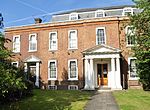Lord William FitzRoy
1782 births1857 deathsFitzRoy familyKnights Commander of the Order of the BathMembers of the Parliament of the United Kingdom for English constituencies ... and 8 more
Royal Navy personnel of the French Revolutionary WarsRoyal Navy personnel of the Napoleonic WarsRoyal Navy rear admiralsUK MPs 1806–1807UK MPs 1807–1812Use British English from November 2013Whig (British political party) MPs for English constituenciesYounger sons of dukes
Admiral Lord William FitzRoy (1 June 1782 – 13 May 1857), was an officer of the British Royal Navy who served during the French Revolutionary and Napoleonic Wars, and also as a Member of Parliament.
Excerpt from the Wikipedia article Lord William FitzRoy (License: CC BY-SA 3.0, Authors).Lord William FitzRoy
Avenue Gardens, London East Sheen (London Borough of Richmond upon Thames)
Geographical coordinates (GPS) Address Nearby Places Show on map
Geographical coordinates (GPS)
| Latitude | Longitude |
|---|---|
| N 51.467027777778 ° | E -0.25825 ° |
Address
The Lodge
Avenue Gardens
SW14 8BP London, East Sheen (London Borough of Richmond upon Thames)
England, United Kingdom
Open on Google Maps





